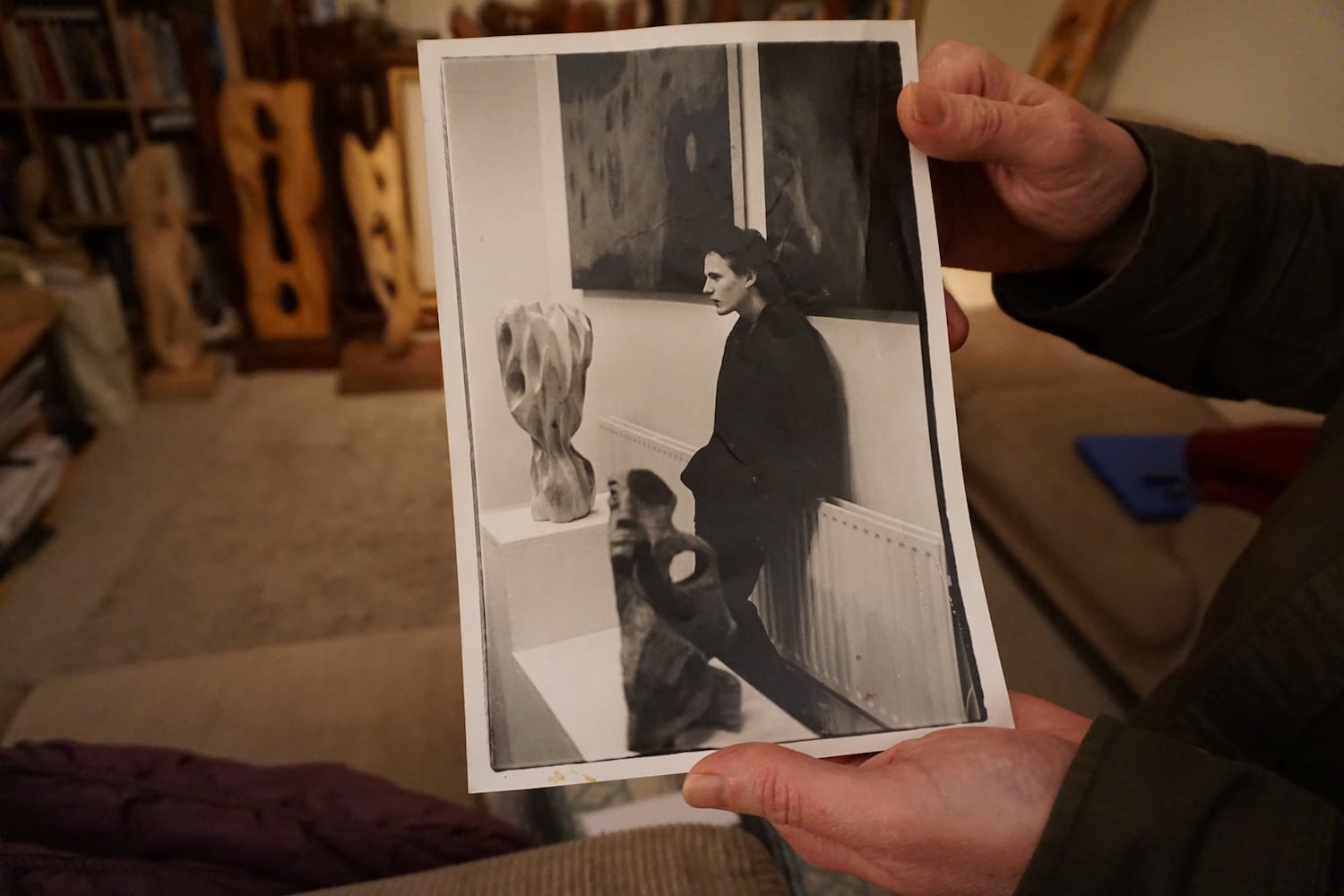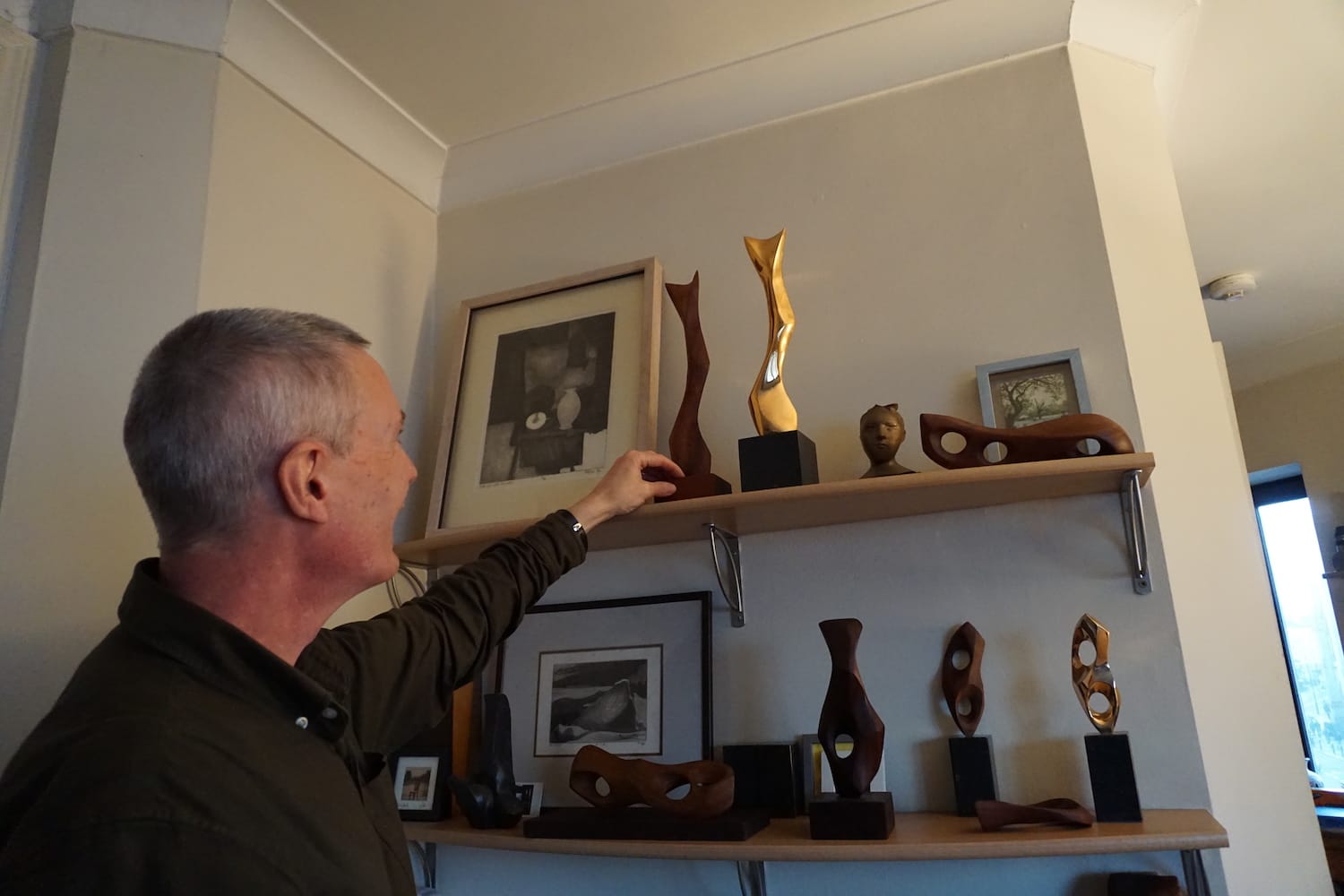What’s the best way to tell area residents about plans for a new asylum shelter nearby?
The government should tell communities directly about plans for new asylum shelters, some activists and politicians say.
Every time Kevin Gaines has worked with or around other artists, he’s picked things up – a mallet, a forgotten skill, or just the energy and creativity of a place, he says.

When Kevin Gaines showed up at his new workshop – a little shed in the yard of the former Moxie Studios – he hadn’t sculpted anything in almost 10 years.
He had a lovely piece of African hardwood called iroko, left from the end post of a staircase. Someone had given it to him.
“I sat there in my little studio, a concrete bunker, starting at this rectangular block of wood with my box of chisels next to me, going, ‘What do I do now?’” Gaines says, and laughs. “It had been so long since I actually carved anything.”
Gaines is sitting in his apartment in the Liberties. Behind him, silky, twisting wooden sculptures sprout up from the sitting-room carpet.
Gaines walks over and plucks up a chocolatey-brown one. It’s smooth and curved – that first piece he made at the studio.
“It’s two pieces of wood that were joined together. See that line? You can see the slight difference in the colour,” he says, setting it down on a low table.
There are curving pieces of wood of varying lengths on most surfaces at Gaines’ place, and smaller sculptures, cast in bronze, on his bookshelves.
All of these pieces have been living here for the past few years. Moxie Studios closed down in 2014. Gaines is looking for a workshop suitable for sculpting. These days, that’s hard to find.
“It’s loud, messy work, and you’ve got woodchips flying everywhere,” he says. It’s got to be ground floor, and either insulated well or a bit away from other studios.
Every time Gaines has worked with or around other artists, he’s picked things up – a mallet, a forgotten skill, or just the energy and creativity of a place.
“This is how I learned to sculpt,” Gaines says, walking towards his mantlepiece and picking up a framed photograph of two white-haired men.
One of them is his late father Fergus. The other is his dad’s friend, the Russian sculptor and art critic Lev Neznansky.
Gaines has never had formal training in sculpture. His informal training began with Neznansky.
His dad met the sculptor while taking Russian-language classes in UCD in the late ’70s, early ’80s. Neznansky came in to help the students practice.
From what Gaines understands, Neznansky and his family, originally from Russia, had been granted asylum in Ireland.
His dad and Neznansky just clicked as friends, says Gaines. Which was funny in a way.
“My dad was a mathematician, very Catholic, very Irish. Not necessarily strict in his beliefs, but he had a certain value system. Lev was bohemian, Russian, artistic,” says Gaines. “But the pair of them, they had just an amazing friendship.”
Gaines says, as he picks up a sinewy chunk of blonde wood, “This is the first piece of sculpture I ever made.”
Unlike the smooth, liquid texture of the others in the room, this one is a bit rougher. The chisel marks are visible.
Gaines made it at Neznansky’s studio, in County Wexford, in 1990. The sculptor had agreed to take him on to do work experience for a FÁS course.

At 21, Gaines was full of youthful enthusiasm, he says. After his dad dropped him off, he thought he’d get right down to the business of making art. He got blisters instead.
On the first morning, Neznansky brought him into the forest behind his studio.
“It was a misty, wet, and drenching kind of day. We walked through the forest, and he was looking at various fallen chunks of wood. He looked at this one – a big chunk in amongst all these thorns – and he went, ‘Hmm that’s good.’”
He handed Gaines a bow saw and left.
After a struggle, Gaines brought the piece of wood into the studio. “He was like, ‘Yeah, good. Okay, now I show you how to sharpen chisels,’” Gaines says, putting on a Russian accent.
The first time Gaines used a chisel and mallet, he was tentative.
“And Lev would come over and he’d take the chisel and mallet and [sculpt] so fluidly, fast, fluently, with absolute precision and control,” Gaines says.
“He was like, ‘You have to loosen your body and you have to feel that flow.’ I was kind of nervous and stiff and afraid of making a mistake. But the funny thing is, after some days, I kind of found my rhythm.”
As the piece Gaines now holds in his hands began to take shape, he wanted it to be a head, face and torso.
Neznansky guided him another way, without ever giving direct advice.
“He would always come up with something that would surprise you. And I was looking at this piece and so on, Lev came out, he picked it up, he looked at it and he went, ‘Ah, now it’s much more interesting,’” Gaines says, turning the sculpture upside down.
“It made me see the abstract and not concentrate so much on trying to make something representative.”
Gains laughs. “He was extraordinary.”
When Gaines got back to Dublin, he was eager to find another sculptor to take him on.
He remembers knocking on the studio door of the sculptor Cathy Carman every day (she was out of town, and they didn’t have mobile phones) until one day it opened. It was a wooden door onto the street, at the Temple Bar Gallery and Studios.
He says of Temple Bar in the early 1990s: “Tourists would not have gone near the place with a barge pole back in the day.” But there were derelict buildings, so rents were cheap for artists and musicians.
Carman secured funding for a year-long apprenticeship for Gaines.
On his first day, she asked him to carve out a curved shape she’d drawn on a piece of wood.
“This was after I’d worked with Lev; working on my own piece was freeform. But this had to be more specific and precise, and I was terrified. I thought, ‘Oh god, if I make a mess of this, this is me gone!’”
Carman left him to get on with it.
“She came back after a while and she went, ‘Ah come on! You won’t get that done before Christmas at the rate you’re going’.”
Gaines gestures that she took up the tools and gracefully carved the piece, in a series of feather light taps.
With Carman, Gaines also learned to cast in bronze, which is highly skilled work. He made smaller moulds and helped to cast and clean them. He also learned patination – applying chemical solutions to heated bronze to achieve different colours.
Gaines gets up to retrieve some small, mottled-green bronze sculptures from his shelves.
“I learned a lot of that as an apprentice while working with Cathy,” he says.
All the wood that Gaines carves with is reclaimed. Pieces of window frames. Scaffolding planks. Fire logs.
“I use stuff that’s basically been found or abandoned or considered possibly not that interesting and kind of reinvent it.”
He pulls three slender, dark brown totems up from the floor. The wood is from an old door frame, and is also iroko, the African hardwood.
Iroko is sacred to some in Nigeria, Gaines says.
“They were abandoned in a skip, and by carving them, it brings back the element of mystery.”
Gaines remembers the first time he realised that sculpting had become intuitive to him, as it had been for Carman and Neznansky.
At Moxie Studios, another artist asked Gaines to show him how to carve a small piece of wood.
Gaines took up a flat chisel and a mallet and gently tapped the wood, told the guy not to clobber it.
“And he’s like, ‘Right, I see what you’re doing there.’ And he took the mallet and took the chisel, and he reminded me of me when I was 20. He kind of braced himself and … buried the chisel into the piece of wood.”
Gaines told him to relax and that it’s like playing golf, or practising martial arts. The strength comes from your core, not your arms.
“I said this” – Gaines chisels the air with his hands – “should be effortless.”
“I kind of realised that for me, nowadays, carving like that is like brushing my teeth. It’s just something that comes so naturally.”

After his initial apprenticeship years, Gaines went off to California. He did a bit of sculpting and showing in exhibitions, but he gradually drifted away from it.
“It became something that I once did and that I always promised myself I’d get back to.”
And he did, eventually. He rented a workshop at Moxie Studios in 2011 and sculpted full-time for three years.
One day, the sculptor John Coll, who made the Patrick Kavanagh statue on the Grand Canal, poked his head in. He had a studio there, too.
“He said, ‘Ah, I thought I heard the familiar tap of carving going on there,’” Gaines says. “He gave me a mallet, which I thought was really lovely.”
Coll inspected a few of Gaines’ smaller pieces and invited him over to his studio, to make moulds to cast in bronze.
“So John is the one who got me back into the idea of casting in bronze,” he says. “I patinated it myself in his studio, and we drilled and mounted it onto a stone base.”
Coll mentioned that the small bronze sculpture looked edible. When Gaines got back from lunch, Coll had pots of chocolate melting in his studio.
“We cast a perfect replica of this in dark chocolate. It was superb. It was great fun.”
Gaines calls his time at Moxie “the glory years”.
“John just opened my eyes to the possibility of casting in bronze. It just hadn’t occurred to me. Of course, I can make a mould from these small little pieces. But Moxie was fantastic because there were 30, 40 different people up there, from musicians to fashion designers, to photographers, writers.”
In 2014, Gaines says they had to clear out, and the studios were demolished.
“It’s now LinkedIn’s gleaming European headquarters, and you wouldn’t even know what was formerly there.”
Sign up here to get our free email newsletter each Wednesday, with headlines from the week’s online edition, updates from inside the newsroom, and more. It’s a little reminder when we have a new edition out, and a way for you to stay in touch with what we’re doing without having to check social media.
Get our latest headlines in one of them, and recommendations for things to do in Dublin in the other.